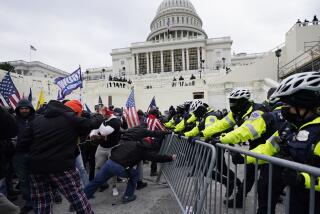Police Missed Leads on British Bombers
LONDON — Police knew of links between suspected extremists and two of the suicide bombers who launched deadly attacks on the transit system here, but they failed to follow up on the leads, in part because they were overwhelmed by a threefold increase in the number of terrorist suspects in Britain, a parliamentary report revealed Thursday.
In the first official findings on the July 7 bombings that killed 52 people and injured more than 700, the Intelligence and Security Committee’s report found that intelligence agencies had tracked two of the bombers to contacts in 2003 and 2004 with unidentified figures who had been the subject of security service investigations.
In an example of one of several missed opportunities, more than one detainee outside the country had identified a man later learned to be the suspected ringleader, Mohamed Sidique Khan, as having traveled to Pakistan in 2003, seeking meetings with Al Qaeda figures.
A photograph of Khan was shown to one of the detainees, who didn’t recognize him. But it was not shown to another captive, who after the bombings would identify Khan as the man who had been in Pakistan, the report revealed.
Authorities blamed a lack of resources for the failure to follow up on every lead, at a time when the number of “primary investigative targets” suspected of ties to terrorism had grown from 250 in 2001 to about 800 in 2005.
There was no sign then that the two men -- in addition to two accomplices -- were engaged in plotting a violent attack in Britain, investigators said. Intelligence about the meetings attended by Khan and fellow bomber Shahzad Tanweer “suggested that their focus was training and insurgency operations in Pakistan, and schemes to defraud financial institutions,” the report said.
With too few resources spread too thin, security agencies had elected to focus their efforts on “more pressing priorities,” such as “the need to disrupt known plans to attack the U.K.,” it said.
“The willingness of these men to use suicide bombing as their method, and to attack vulnerable, civilian targets ... made them doubly difficult to defend against,” Home Secretary John Reid told Parliament on Thursday.
“That is not a comfortable message. But it is important that we are honest about it, if we are to defend ourselves against the threat effectively.”
Security analysts and families of the victims immediately criticized the report for its failure to answer some of the biggest questions about the attacks. For example, it failed to draw any conclusions about Al Qaeda involvement in the assaults, though it documented trips by Khan and Tanweer to Pakistan in 2003, 2004 and February 2005.
“It has not yet been established who they met in Pakistan, but it is assessed as likely that they had some contact with Al Qaeda figures,” the report said.
A Home Office report released Thursday said there was no firm evidence of any Al Qaeda involvement in the bombings, though investigations were continuing.
The parliamentary report discounted earlier media accounts of a purported mastermind who left the country at the time of the attacks, but did not say who else might have been involved, or how the suspects were able to raise the estimated $15,000 it took to travel to Pakistan and to build the homemade bombs used in the attacks.
“What we really need to know more about is the content, the substance of the communications that both Tanweer and Khan had with Pakistani militants. What did they amount to? What information or advice was given to them? It seems unlikely that they weren’t influenced or assisted by anybody,” said Paul Wilkinson, head of the Center for the Study of Terrorism and Political Violence at St. Andrews University.
He said the report fell far short of the U.S. probe into the Sept. 11, 2001, attacks on the World Trade Center and the Pentagon, which, he said, “really got into the fine detail of intelligence failures and the aviation security procedures, and where the airport boarding gate procedures fell down and so forth.”
But the parliamentary report emphasized that the investigation was still open.
“The account is not yet the full picture. The police investigation remains very much a live one, and further information may emerge.”
More to Read
Sign up for Essential California
The most important California stories and recommendations in your inbox every morning.
You may occasionally receive promotional content from the Los Angeles Times.










